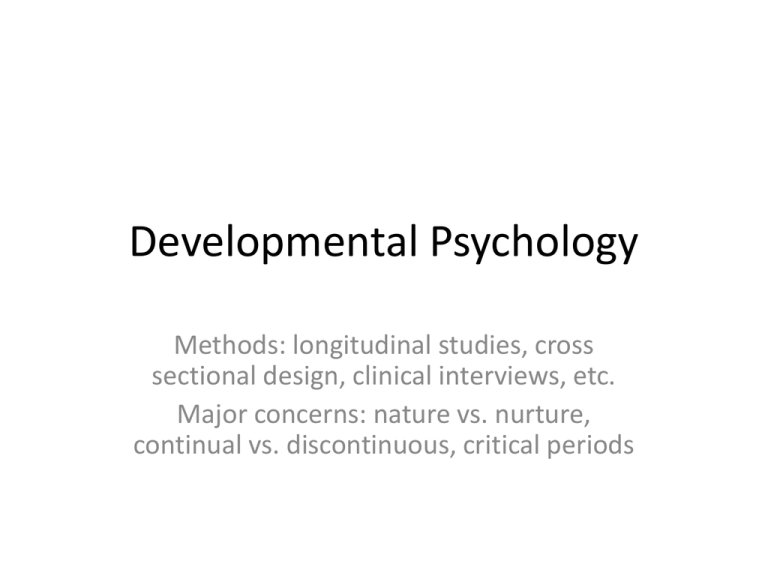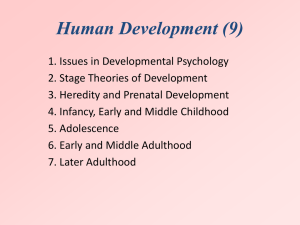
Developmental Psychology
Methods: longitudinal studies, cross
sectional design, clinical interviews, etc.
Major concerns: nature vs. nurture,
continual vs. discontinuous, critical periods
Last Year’s Developmental Theorists
• Cognitive Development—Piaget, Baillargeon,
Vygotsky (socially informed)
• Social development—Attachment—Bowlby
and Ainsworth, Lifespan Development—
Erikson
• Sexual Development—Freud, Horney, Money
and Erhardt, Mead
Neurobiological Brain Development
and Neuroplasticity Theories
• Tell me again about neurons.
• Tell me again about neuroplasticity.
• Dendritic branching is most significant in childhood and
adolescence.
• http://www.youtube.com/watch?v=7jpXxT1Md08 at
minute 39
• Interaction with loving and responsive caregivers
contributes to healthy brain development.
• Listen to
http://www.npr.org/blogs/health/2014/02/20/280237
833/orphans-lonely-beginnings-reveal-how-parentsshape-a-childs-brain
Brain Development
• Brain doubles in size from birth to young adult
hood and folds become more complex,
especially in cognition and emotion areas (PET
and MRI).
Chugani (1999)
•
•
•
•
PET scans—glucose metabolism in newborn babies
Little activity in cerebral cortex (executive function)
Activity in brain stem and thalamus (reflexes)
Activity in limbic system--amygdala, hippocampus, and
cingulate cortex (emotions, memories, and bonding
areasattachment)
• Lower brain levels developed first and then higher levels—6
to 9 months increased activity in frontal lobes, prefrontal
areas of cortex, and improved cognitive competence.
• http://www.dana.org/Cerebrum/2004/FineTuning_the_Baby_Brain/ and
http://phy.ucsf.edu/~houde/coleman/chugani.pdf
Bachevalier et al. (1999)
• http://www.ncbi.nlm.nih.gov/pmc/articles/P
MC2913301/
Case (1991)
• Brain changes between five and seven enable
the frontal lobes to coordinate activities of
other brain centers so more complex
behaviors possible—attention control, forming
explicit plans, self-reflecting
• Observing humans with damage to frontal
lobes and experimental research with
animals—unable to plan ahead or stick to
plans, no self-control, easily distracted.
Giedd (2004)
•
•
•
•
•
•
•
MRI scans, longitudinal study, healthy children
95% of brain formed when child is around five or six, but prefrontal cortex starts growing again in
adolescence.
PFC is last to mature and responsible for cognitive processes such as planning, impulse control, direction
of attention, and decision making.
gray matter development between the age of 4-21 years using quantitative four-dimensional maps and
time-lapse sequences. Thirteen healthy children for whom anatomic brain MRI scans were obtained every
2 years, for 8-10 years, were studied. http://www.ncbi.nlm.nih.gov/pubmed/15148381
Magnetic resonance imaging (MRI) provides accurate anatomical brain images without the use of ionizing
radiation, allowing longitudinal studies of brain morphometry during adolescent development. Results
from an ongoing brain imaging project being conducted at the Child Psychiatry Branch of the National
Institute of Mental Health indicate dynamic changes in brain anatomy throughout adolescence. White
matter increases in a roughly linear pattern, with minor differences in slope in the four major lobes
(frontal, parietal, temporal, occipital). Cortical gray matter follows an inverted U-shape developmental
course with greater regional variation than white matter. For instance, frontal gray matter volume peaks at
about age 11.0 years in girls and 12.1 years in boys, whereas temporal gray matter volume peaks at about
age at 16.7 years in girls and 16.2 years in boys. The dorsal lateral prefrontal cortex, important for
controlling impulses, is among the latest brain regions to mature without reaching adult dimensions until
the early 20s. The details of the relationships between anatomical changes and behavioral changes, and
the forces that influence brain development, have not been well established and remain a prominent goal
of ongoing investigations.
http://www.ncbi.nlm.nih.gov/pubmed/15251877
http://www.youtube.com/watch?v=Bhv3bA_qG24
Waber (2007)
• MRI Study of Normal Brain Development
• Longitudinal, 450 healthy children aged 6-18,
began in 1999
• MRI scans and battery of cognitive function tests
(processing, memory, reading, calculation, IQ,
and psychosocial)
• Age predicts performance. Steep increase in
function from age six but levelled off between 10
and 12.
• http://stbb.nichd.nih.gov/pdf/NIH_MRI_neurops
ychological.pdf
Stathearn et al. (2001)
• Child neglect associated with delayed
cognitive development and head growth in
young children.
• http://pediatrics.aappublications.org/content/
108/1/142
Rosenzweig and Bennet (1972)
•
•
Brain changes in response to experience
Reports a study in which rats placed in enriched or impoverished environments for 4-10 wk.
differed in brain anatomy and chemistry. Ss with enriched experience had heavier and thicker
cerebral cortexes, greater total activity of acetylcholinesterase but less activity per unit of
tissue weight, greater activity of cholinesterase, more glial cells, larger cell bodies and nuclei,
more dendritic spines, larger synaptic junctions, and increased RNA/DNA ratios. The greatest
differences were found in the occipital cortex. It is suggested that daily 2-hr enrichment
periods may be effective if the rat is stimulated to interact with objects in the environment.
Changes were not caused by variations in amount of handling, stress, or maturation rate.
(PsycINFO Database Record (c) 2012 APA, all rights reserved)
• http://psycnet.apa.org/psycinfo/197222480-001
• http://neur2201.unsw.wikispaces.net/file/v
iew/plasticity.pdf/156591175/plasticity.pdf
Strengths and Weaknesses of
neurobiological theories?
• Say what?
Cognitive Development
• Piaget and his methods
• Child is active scientist, builds mental representations (schemas),
stage theory
• Genetically based schemas (sucking and grasping as babies) to
thinking schemas
• Adaptation in the form of assimilation—new information integrated
into existing cognitive schemas or accommodation—existing
schemas modified to fit new information or new schemas are
created.
• Sensorimotor-object permanence, preoperational-egocentricism,
conservation, concrete operational, formal operational
• Piaget and Inhelder (1956) mountain task with doll, at six different
viewpoints
• Egocentricism, conservation
Object permanence in young infants: further
evidence. (Baillargeon and DeVos, 1991)
•
•
Abstract: Recent evidence suggests that 4.5- and even 3.5-month-old infants realize that objects
continue to exist when hidden. The goal of the present experiments was to obtain converging
evidence of object permanence in young infants. Experiments were conducted using paradigms
previously used to demonstrate object permanence in 5.5-month-old infants and 6.5-month-old
infants. In one experiment, 3.5-month-old infants watched a short or a tall carrot slide along a
track. The track's center was hidden by a screen with a large window in its upper half. The short
carrot was shorter than the window's lower edge and so did not appear in the window when
passing behind the screen; the tall carrot was taller than the window's lower edge and hence
should have appeared in the window but did not. The infants looked reliably longer at the tall than
at the short carrot event, suggesting that they (a) represented the existence, height, and trajectory
of each carrot behind the screen and (b) expected the tall carrot to appear in the screen window
and were surprised that it did not. Control trials supported this interpretation. In another
experiment, 4.0-month-old infants saw a toy car roll along a track that was partly hidden by a
screen. A large toy mouse was placed behind the screen, either on top or in back of the track. The
female infants looked reliably longer when the mouse stood on top as opposed to in back of the
track, suggesting that they (a) represented the existence and trajectory of the car behind the
screen, (b) represented the existence and location of the mouse behind the screen, and (c) were
surprised to see the car reappear from behind the screen when the mouse stood in its path. A
second experiment supported this interpretation. The results of these experiments provide further
evidence that infants aged 3.5 months and older are able to represent and to reason about hidden
objects.
http://www.ncbi.nlm.nih.gov/pubmed/1786712
Hughes (1975)
• Policeman Doll Study
• http://www.simplypsychology.org/preoperati
onal.html
McCarrigle and Donaldson (1974)
• http://www.simplypsychology.org/concreteoperational.html
Strengths and Limitations of Piaget’s
theory?
• Say what?
Vygotsky’s sociocultural approach to
cognitive development
Zone of proximal development, scaffolding,
cooperative learning
http://www.simplypsychology.org/vygotsky.html
Which is better biological, cognitive, or
socio-cultural theories?
• Say what?
Cognitive Development as per Social
and Environmental Variables
• SES, parenting, nutrition, stimulating
environments, pollution, etc.
Farah et al. (2005)
• http://www.iom.edu/~/media/Files/Activity%
20Files/Children/NeuroEffectsChildren/Farah.
pdf
Consider Krugman.
• http://www.nytimes.com/2008/02/18/opinio
n/18krugman.html?_r=0
Bhoomika et al. (2008)
•
•
•
Methods: Twenty children identified as malnourished and twenty as adequately
nourished in the age groups of 5–7 years and 8–10 years were examined.
NIMHANS neuropsychological battery for children sensitive to the effects of brain
dysfunction and age related improvement was employed. The battery consisted of
tests of motor speed, attention, visuospatial ability, executive functions,
comprehension and learning and memory
Results: Development of cognitive processes appeared to be governed by both
age and nutritional status. Malnourished children performed poor on tests of
attention, working memory, learning and memory and visuospatial ability except
on the test of motor speed and coordination. Age related improvement was not
observed on tests of design fluency, working memory, visual construction, learning
and memory in malnourished children. However, age related improvement was
observed on tests of attention, visual perception, and verbal comprehension in
malnourished children even though the performance was deficient as compared to
the performance level of adequately nourished children.
http://www.behavioralandbrainfunctions.com/content/4/1/31
Wertheimer (2003)
• http://www.childtrends.org/wpcontent/uploads/2003/05/Child_Trends2003_05_01_RB_PoorFamilies.pdf
Werner and Smith (1992)
• http://www.pathwaysrtc.pdx.edu/pdf/fpS050
4.pdf
Pungello et al. (2006)
• Abecedarian Project
• http://abc.fpg.unc.edu/
Consider.
• http://www.youtube.com/watch?v=6i105vkXV
ok
ENVIRONMENTAL VARIABLES
• Rosenzweig again…
Liu et al. (2000)
• Nature Neuroscience 3, 799 - 806 (2000) Maternal care, hippocampal
synaptogenesis and cognitive development in rats. Dong Liu, Josie Diorio,
Jamie C. Day, Darlene D. Francis & Michael J. Meaney
• We report that variations in maternal care in the rat promote
hippocampal synaptogenesis and spatial learning and memory through
systems known to mediate experience-dependent neural development.
Thus, the offspring of mothers that show high levels of pup licking and
grooming and arched-back nursing showed increased expression of
NMDA receptor subunit and brain-derived neurotrophic factor (BDNF)
mRNA, increased cholinergic innervation of the hippocampus and
enhanced spatial learning and memory. A cross-fostering study provided
evidence for a direct relationship between maternal behavior and
hippocampal development, although not all neonates were equally
sensitive to variations in maternal care.
• http://www.nature.com/neuro/journal/v3/n8/abs/nn0800_799.html
Farah et al. (2008)
• http://www.psych.upenn.edu/~mfarah/Devel
opment-EnviroStimParentalNurt.pdf
Attachment
• Bowlby (1973)
• Internal working model—ideas of attachment
figures and expectations, ideas about self,
ideas about how self and others relate
• http://www.simplypsychology.org/bowlby.ht
ml
• Schaffer and others, too
• https://www.youtube.com/watch?v=KVskAjrC
kSU
Attachment
• Remember Ainsworth—strange situation paradigm (1978),
student of Bowlby.
• Ganda Project (1969)—naturalistic observation of 28
mothers in Uganda over nine months, interviewed mothers
and measured maternal sensitivity to infant’s (15 to 24
months) signals and needs, replicated in USA in 1971 with
26 families—70% secure, 10% ambivalent, 20% avoidant
• http://www.simplypsychology.org/mary-ainsworth.html
• Campos et al. (1983) found 62% secure, 15% ambivalent,
and 15% avoidant
• Main and Solomon (1986) added Type D
disorganized/disoriented attachment
Kagan (1982)
• Temperaments
• https://www.youtube.com/watch?v=CGjO1Kw
ltOw
Brazelton (1975)
• Observational study of mothers and babies
during their interaction, found that both
imitated each other, took turns to initiate new
movements=interactional synchrony
Van Ijzendoorn and Kroonenberg
(1988)
• http://psychteacheraqa.blogspot.com/2013/0
4/cultural-variations-in-attachment-van.html
• Review of 32 worldwide studies, involving 8
countries and over 2000 infants; in Japan,
ambivalent was more common but no
avoidant; secure was most common in West
Hazan and Shaver (1987)
• “Romantic Love Conceptualized as an Attachment Process”
• experienced differently because of variations in their
attachment histories—continuity of
• “inner working models”—early to later
• Newspaper, love quiz—56% respondents secure
• Read and evaluate:
http://www2.psych.ubc.ca/~schaller/Psyc591Readings/Haz
anShaver1987.pdf
• http://www.psy.miami.edu/faculty/dmessinger/c_c/rsrcs/r
dgs/attach/hazanandshaver.pdf
Feeney, Noller and Callan (1994)
• http://citeseerx.ist.psu.edu/viewdoc/downloa
d?doi=10.1.1.324.2280&rep=rep1&type=pdf
• Attachment patterns in stable couples tend to
be secure; attachment patterns seem to be
flexible and may change; the relationship,
stable and satisfying or negative, can lead to a
change in internal working models of self and
others.
Deprivation and Trauma
• DEPRIVATION--physical, emotional, or social;
often related to institutionalization, poverty,
parental problems e.g. alcoholism or mental
illness
• TRAUMA—powerful shock e.g. divorce, death
of a parent, physical or sexual abuse, natural
disasters, war
Carion et al. (2009)
• Objective Youth who experience interpersonal trauma and have
posttraumatic stress symptoms (PTSS) develop cognitive deficits that
impact their development. Our goal is to investigate the function of the
hippocampus in adolescents with PTSS during a memory processing task.
Methods Twenty-seven adolescents between the ages of 10–17 years
(16 with PTSS and 11 healthy controls) encoded and retrieved visually
presented nouns (Verbal Declarative Memory Task) while undergoing fMRI
scanning. Results The PTSS group demonstrated reduced activation of
the right hippocampus during the retrieval component of the task.
Further, severity of symptoms of avoidance and numbing correlated with
reduced left hippocampal activation during retrieval. Conclusions
Decreased activity of the hippocampus during a verbal memory task may
be a neurofunctional marker of PTSS in youth with history of interpersonal
trauma. The results of this study may facilitate the development of
focused treatments and may be of utility when assessing treatment
outcome for PTSS.
• http://www.ncbi.nlm.nih.gov/pmc/articles/PMC2910941/
Yehuda et al. (2001)
•
•
•
Childhood trauma and risk for PTSD: relationship to intergenerational effects of
trauma, parental PTSD, and cortisol excretion.
Abstract: Among the adverse mental health consequences of childhood trauma is
the risk related to the development of posttraumatic stress disorder (PTSD) in
adulthood. Other risk factors for PTSD. including parental trauma exposure and
parental PTSD, can also contribute to the experience of child trauma. We examined
associations between childhood trauma and PTSD in 51 adult children of Holocaust
survivors and 41 comparison subjects. in consideration of parental trauma
exposure and parental PTSD. We also examined these variables in relation to 24-hr
urinary cortisol levels. Adult offspring of Holocaust survivors showed significantly
higher levels of self-reported childhood trauma, particularly emotional abuse and
neglect. relative to comparison subjects. The difference was largely attributable to
parental PTSD. Self-reported childhood trauma was also related to severity of PTSD
in subjects, and emotional abuse was significantly associated with 24-hr mean
urinary cortisol secretion. We conclude that the experience of childhood trauma
may be an important factor in the transmission of PTSD from parent to child.
http://www.ncbi.nlm.nih.gov/pubmed/11523857
English and Romanian adoptees study
(1990s)—324 Romanian adoptees
• http://www.nuffieldfoundation.org/english-and-romanianadoptee-study
• http://www.kcl.ac.uk/iop/depts/mrc/research/theenglisha
ndromaniandoptee(era)project.aspx
• Rutter et al. (2004)—144 6 y.o. children
• Rates of cognitive impairment and disinhibited attachment
behavior
• https://www.youtube.com/watch?v=igC9R45TS5E
• http://www.apa.org/monitor/feb04/doearly.aspx
• https://www.youtube.com/watch?v=rFMZljG2LEA
• https://www.youtube.com/watch?v=98BwGolMdYM
• https://www.youtube.com/watch?v=VDR5xpLEx-U
Perry and Pollard (1997)
• “Altered brain development following global
neglect in early childhood”—CT scans.
• http://www.sakkyndig.com/psykologi/artvit/p
erry1997.pdf
• http://www.ou.edu/cwtraining/assets/pdf/ha
ndouts/2010/Altered%20brain%20developme
nt%20following%20global%20neglect.pdf
Resilience
• Rutter (1990) and Schoon et al. (2002):
maintaining adaptive functioning in spite of
serious risk factors
• Wyman et al. (2000): a child’s achievement of
positive developmental outcomes and avoidance
of maladaptive outcomes under adverse
conditions
• Risk factors and protective factors (temperament,
close relationship, social support)—revisit
Werner and Smith (2005) Kauai study
Wright and Masten (2006)
• Not a single trait but multiple contextual factors
• file:///C:/Users/cmcnamar/Downloads/97814614
36607-c1.pdf
• http://www.esc19.net/brac/military_family_reso
urces/Masten%20and%20Obradovic%20Compete
nce%20and%20Resilience%20inDevelopment%20
2006.pdf
• https://www.youtube.com/watch?v=GBMet8oIvX
Q
Schoon and Bartley (2008)
• Examine factors and processes that enable
individuals to beat the odds—situational
rather than dispositional in order to avoid
blaming the victim
• How to promote resilience by removing
obstacles and creating opportunities
The Triple P—Positive Parenting
Program
• http://www.triplep.net/glo-en/home/
• https://www.youtube.com/watch?v=VF7i8_sxRtQ
• https://www.youtube.com/watch?v=9ACcywo29
80
• Sanders: http://www.triplepnederland.nl/files/9613/3458/1155/Achtergrond
_TripleP_Sanders_2012.pdf
The High/Scope Perry Preschool
Project
• Began 1962, 123 high-risk, low SES, low IQ
scores, 3-4 y.o. African-American children; 58
in program group; 65 in control
• http://www.highscope.org/content.asp?conte
ntid=219
• http://www.highscope.org/file/Research/Perr
yProject/specialsummary_rev2011_02_2.pdf
• https://www.youtube.com/watch?v=dnGEuHfC8w
Big Brothers Big Sisters (BBS)
mentoring program
• Social support from a caring adult to a high-risk
child or adolescent can promote a healthy
development in spite of environmental factors.
• https://www.youtube.com/watch?v=tvblk8qZi4E
• https://www.youtube.com/watch?v=DFsur7ZR2
ZA
• Tierney et al. (1995):
http://www.promisingpractices.net/program.as
p?programid=125
Gender Roles
Evolutionary theory (men aggressive; women
nurturing)
Psychosexual differentiation theory (male
androgens)
Biosocial theory (intersex)
Social learning theory-modeling
Gender schema theory-beliefs, thinking, labels,
conformity
Sociocultural theory or social role theory
Best explanation?
Research
• Research whether gender roles are nature,
nurture, continuously, discontinuously,
biologically, socially, environmentally, or
cognitively informed.
• some helpful terms: evolutionary theory,
psychosexual differentiation theory, biosocial
theory, Money and Ehrhardt, social learning
theory, gender schema theory, Martin and
Halverson, Matsumoto, Eagly, Mead, Goffman,
Reinicke, Engle and Breaux
Gender Roles Studies
Wolf et al. (2002)
Smith and Lloyd (1978) Baby X experiment
Whiting and Edwards (1973)
Stroufe et al. (1993) peer socialization
Bower (1989) one year old playing
Bem (1981)
Martin and Halverson (1978) gender identity construction
Martin and Halverson (1983) male and female activities
Fagot and Hagan (1991) mother and father interactions
Fagot (1985) gender policing
Reinicke (2006) Denmark fathers
Engle and Breaux (1994) fathers and parenting
Best et al. (1977) gender stereotypes in UK, Ireland and US
participants, method, conclusions, criticism?
nature, nurture, biological, social, cognitive?
matches with which theory?
Adolescence
PHYSICAL CHANGE AND IDENTITY
• Schlegel and Berry (1991)
• Hall (1904)
• Simmons and Blyth (1987)-cultural ideal hypothesis
• Caufmann and Steinberg (1996)
• Fredrickson and Roberts (1997)-objectification theory
• Stice and Withenton (2002)
• Ferron (1997) US and French
participants, method, conclusions, criticism?
nature, nurture, biological, social, cognitive?
matches with which theory?
Adolescence and psychological
research
• Erikson (1950s)
• Espin et al. (1990)-longitudinal letter study
• Rutter et al. (1976)-Isle of Wight
• O’Connell (1976)-married women with children
• Condon (1987)-Canadian Inuit
participants, method, conclusions, criticism?
nature, nurture, biological, social, cognitive?
matches with which theory?



